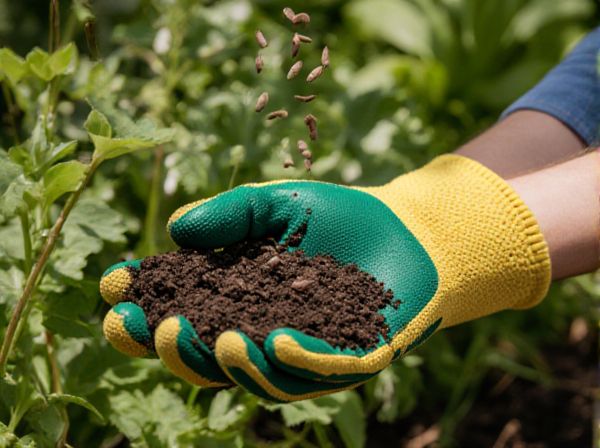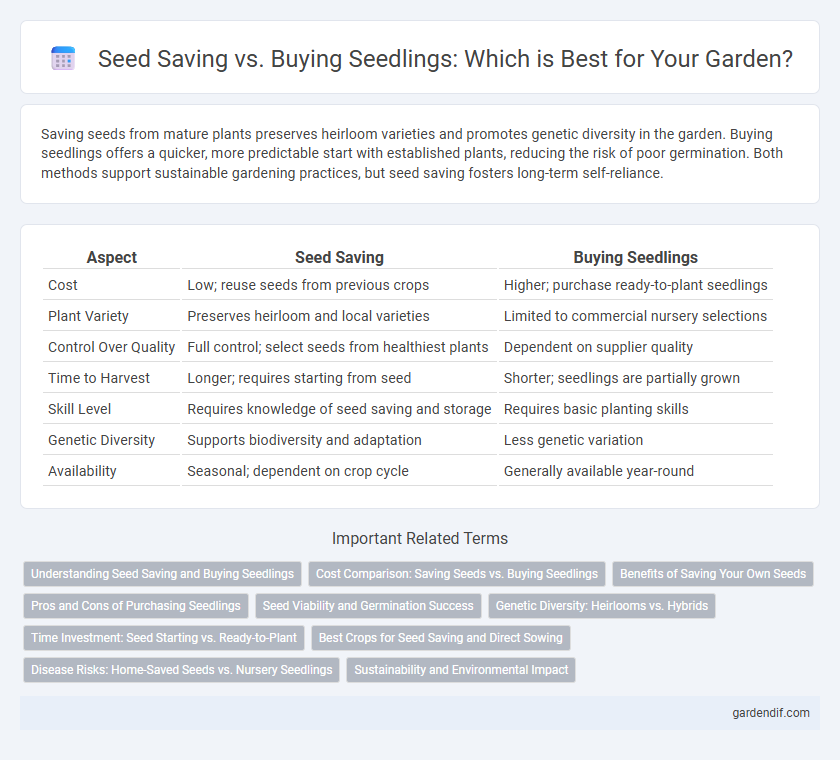
Seed Saving vs Buying Seedlings Illustration
Saving seeds from mature plants preserves heirloom varieties and promotes genetic diversity in the garden. Buying seedlings offers a quicker, more predictable start with established plants, reducing the risk of poor germination. Both methods support sustainable gardening practices, but seed saving fosters long-term self-reliance.
Table of Comparison
| Aspect | Seed Saving | Buying Seedlings |
|---|---|---|
| Cost | Low; reuse seeds from previous crops | Higher; purchase ready-to-plant seedlings |
| Plant Variety | Preserves heirloom and local varieties | Limited to commercial nursery selections |
| Control Over Quality | Full control; select seeds from healthiest plants | Dependent on supplier quality |
| Time to Harvest | Longer; requires starting from seed | Shorter; seedlings are partially grown |
| Skill Level | Requires knowledge of seed saving and storage | Requires basic planting skills |
| Genetic Diversity | Supports biodiversity and adaptation | Less genetic variation |
| Availability | Seasonal; dependent on crop cycle | Generally available year-round |
Understanding Seed Saving and Buying Seedlings
Seed saving involves collecting and storing seeds from mature plants to cultivate future crops, preserving genetic diversity and reducing costs. Buying seedlings offers a convenient and time-saving option, ensuring healthy young plants with established root systems for quicker garden establishment. Understanding the benefits and limitations of both methods helps gardeners optimize growth cycles and maintain sustainable plant production.
Cost Comparison: Saving Seeds vs. Buying Seedlings
Saving seeds significantly reduces gardening costs by eliminating the need to purchase new seedlings each season, allowing gardeners to cultivate plants from previous harvests at minimal expense. Although buying seedlings offers convenience and immediate plant establishment, the ongoing cost accumulates over time compared to the one-time investment in seed-saving tools and storage. Seed saving also supports genetic diversity and adaptability, which can lead to healthier, more resilient plants, indirectly lowering long-term gardening expenses.
Benefits of Saving Your Own Seeds
Saving your own seeds preserves plant varieties adapted to your local climate, ensuring stronger growth and higher yields over time. It promotes genetic diversity by allowing gardeners to select the best traits from their healthiest plants, leading to more resilient crops. This cost-effective practice also reduces dependency on commercial seed suppliers, saving money and encouraging sustainable gardening.
Pros and Cons of Purchasing Seedlings
Purchasing seedlings offers the advantage of faster garden establishment and often higher initial survival rates compared to seed saving, especially for novice gardeners. However, seedlings can be more expensive and may limit plant variety selection since buyers depend on available nursery stock rather than the diverse genetic options accessible through seed saving. Additionally, seedlings are more susceptible to transplant shock and disease introduced during propagation, impacting long-term plant health.
Seed Viability and Germination Success
Seed saving preserves genetic diversity and ensures seed viability by selecting seeds from healthy, mature plants adapted to local conditions. Buying seedlings offers immediate plant establishment and higher germination success rates but may limit genetic variation and adaptability. Proper storage conditions enhance seed longevity, directly impacting seed viability and overall germination success in seed saving.
Genetic Diversity: Heirlooms vs. Hybrids
Saving heirloom seeds preserves genetic diversity by maintaining traditional plant varieties adapted to local environments, whereas buying hybrid seedlings often limits diversity due to uniform, commercially bred traits. Heirloom seeds contribute to resilience against diseases and varying climate conditions by protecting a broad gene pool. Hybrids, while offering consistency and high yield, typically do not produce stable seeds, making saved seeds from hybrids less viable for future planting.
Time Investment: Seed Starting vs. Ready-to-Plant
Saving seeds demands significant time investment in seed collection, cleaning, and proper storage to ensure viability; gardeners must also spend weeks starting seeds indoors to achieve healthy seedlings. In contrast, buying ready-to-plant seedlings drastically reduces the time needed before transplantation, allowing immediate planting and growth in the garden. Evaluating the time commitment for seed starting versus purchasing seedlings is crucial for effective garden planning and optimizing seasonal yields.
Best Crops for Seed Saving and Direct Sowing
Tomatoes, beans, and lettuce are among the best crops for seed saving due to their reliable seed viability and ease of harvesting seeds. Carrots, radishes, and peas thrive when directly sown into soil, ensuring strong root development and minimal transplant shock. Choosing between seed saving and buying seedlings depends on factors like crop type, garden size, and seasonality to maximize yield and sustainability.
Disease Risks: Home-Saved Seeds vs. Nursery Seedlings
Home-saved seeds carry a higher risk of harboring seed-borne diseases such as damping-off or fungal infections, potentially compromising plant health from the start. Nursery seedlings, while generally more disease-free due to controlled growing conditions, can still introduce pathogens through contaminated soil or handling. Evaluating disease risks thoroughly can guide gardeners in choosing between the cost-effectiveness of seed saving and the relative safety of nursery-grown seedlings.
Sustainability and Environmental Impact
Seed saving reduces reliance on commercial agriculture, lowering carbon emissions associated with seed production, packaging, and transportation. Preserving heirloom seeds supports biodiversity by maintaining genetic variety critical for resilient ecosystems. Buying seedlings often involves resource-intensive nursery practices, while seed saving promotes sustainable gardening by minimizing waste and conserving local plant adaptations.
Seed Saving vs Buying Seedlings Infographic

 gardendif.com
gardendif.com